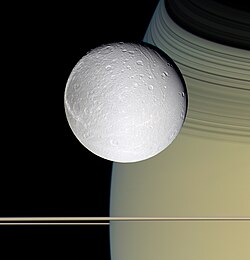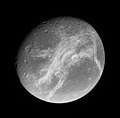 Cassini spacecraft view of Dione | |
| Discovery | |
|---|---|
| Discovered by | G. D. Cassini |
| Discovery date | March 21, 1684 |
| Designations | |
| Alternate name | Saturn IV |
| Adjective | Dionean |
| Semi-major axis | 377 396 km |
| Eccentricity | 0.002 2[1] |
| Orbital period | 2.736 915 d[1] |
| Inclination | 0.019° (to Saturn's equator) |
| Satellite of | Saturn |
| Physical characteristics | |
| Dimensions | 1127.6 × 1122 × 1120.6 km[2] |
| Mean radius | 561.70 ± 0.45 km[3] (348.96 mi) |
| Mass | (1.095 452 ± 0.000 168) × 1021 kg[3] (3.28 × 10-4 Earths) |
| Mean density | 1.475 7 ± 0.003 6 g/cm³[3] |
| Equatorial surface gravity | 0.231 m/s2 |
| Escape velocity | 0.510 km/s |
| Rotation period | 2.736 915 d (synchronous) |
| Axial tilt | zero |
| Albedo | 0.998 ± 0.004 (geometric)[4] |
| Temperature | 87 K (-186°C) |
| Apparent magnitude | 10.4 [5] |
| | |
Dione (pronounced /daɪˈoʊni/,[6] or as Greek Διώνη) is a moon of Saturn discovered by Giovanni Cassini in 1684.[7] It is named after the titan Dione of Greek mythology. It is also designated Saturn IV.
Name
Cassini named the four moons he discovered (Tethys, Dione, Rhea and Iapetus) Sidera Lodoicea ("the stars of Louis") to honour king Louis XIV. Cassini found Dione using a large aerial telescope he set up on the grounds of the Paris Observatory[8]. The satellites of Saturn were not named until 1847, when William Herschel's son, John Herschel published Results of Astronomical Observations made at the Cape of Good Hope, and suggested the names of the Titans, sisters and brothers of Cronos (the Greek Saturn), be used.[9]
Physical characteristics
Dione is composed primarily of water ice, but as the third densest of Saturn's moons (after Enceladus and Titan, whose density is increased by gravitational compression) it must have a considerable fraction (~ 46%) of denser material like silicate rock in its interior.
Though somewhat smaller and denser, Dione is otherwise very similar to Rhea. They both have similar albedo features and varied terrain, and both have dissimilar leading and trailing hemispheres. Dione's leading hemisphere is heavily cratered and is uniformly bright. Its trailing hemisphere, meanwhile, contains an unusual and distinctive surface feature: a network of bright ice cliffs.
Scientists recognise the following types of Dionean geological feature:
The ice cliffs (formerly 'wispy terrain')
When the Voyager space probe photographed Dione in 1980, it showed what appeared to be wispy features covering its trailing hemisphere. The origin of these features was mysterious, as all that was known was that the material has a high albedo and is thin enough that it does not obscure the surface features underneath. One hypothesis was that shortly after its formation Dione was geologically active, and some process such as ice volcanism resurfaced much of its surface, with the streaks forming from eruptions along cracks in Dione's surface that fell back to the surface as snow or ash. Later, after the internal activity and resurfacing ceased, cratering continued primarily on the leading hemisphere and wiped out the streak patterns there.
This theory was proven wrong by the Cassini probe flyby of December 13, 2004, which produced close-up images. These revealed that the 'wisps' were in fact not ice deposits at all, but rather bright ice cliffs created by tectonic fractures; Dione has been revealed as a world riven by enormous fractures on its trailing hemisphere.
The Cassini orbiter performed a closer flyby of Dione (500 km) on October 11, 2005, and captured oblique images of the cliffs, showing that some of them are several hundred metres high.
Craters
Dione's icy surface includes heavily cratered terrain, moderately cratered plains, lightly cratered plains, and areas of tectonic fractures. The heavily cratered terrain has numerous craters greater than 100 kilometers in diameter. The plains areas tends to have craters less than 30 kilometers in diameter. Some of the plains are more heavily cratered than others. Much of the heavily cratered terrain is located on the trailing hemisphere, with the less cratered plains areas present on the leading hemisphere. This is the opposite of what some scientists expected; Shoemaker and Wolfe[10] proposed a cratering model for a tidally locked satellite with the highest cratering rates on the leading hemisphere and the lowest on the trailing hemisphere. This suggests that during the period of heavy bombardment, Dione was tidally locked to Saturn in the opposite orientation. Because Dione is relatively small, an impact causing a 35 kilometer crater could have spun the satellite. Since there are many craters larger than 35 kilometers, Dione could have been repeatedly spun during its early heavy bombardment. The pattern of cratering since then and the bright albedo of the leading side suggests that Dione has remained in its current orientation for several billion years.
Like Callisto, Dione's craters lack the high relief features seen on the Moon and Mercury; this is probably due to slumping of the weak icy crust over geologic time.
Exploration
Dione was first imaged by the Voyager space probes. It has also been been imaged several times from closer distances by the Cassini orbiter. There was one close targeted fly-by, at a distance of 500 km on 2005 October 11; another similarly close fly-by is planned for 2010 April 7.
See also
- List of geological features on Dione
- The moon Helene, which orbits in Dione's leading Lagrangian point, L4.
- The moon Polydeuces orbits in Dione's trailing Lagrangian point, L5.
Gallery
| Dione as seen by Voyager 1 |









0 comments:
Post a Comment